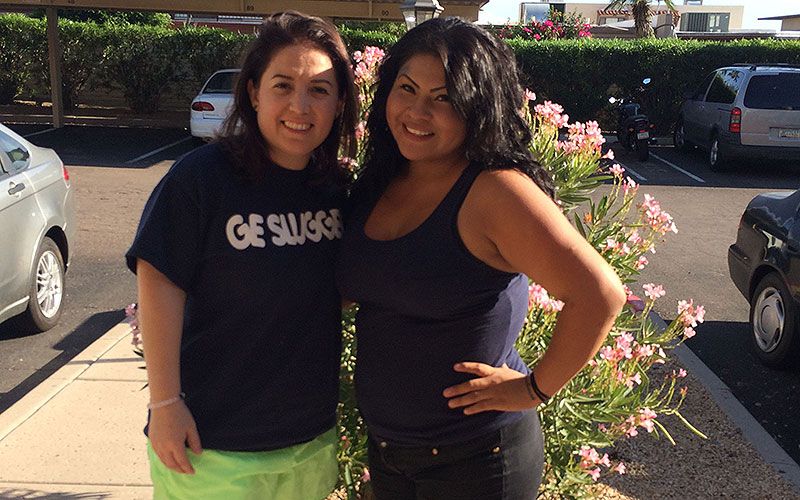
Claudia Torres, left, tries to spend as much time she can with Jaquelyn Cedillo who has a 5 year-old daughter and is trying to start a new life. (Courtesy of Torres family)
Just a few months after foster teen Jaquelyn Cedillo turned 18 and enrolled in the Department of Child Safety’s independent living program, she was sleeping in a park with a boyfriend, having already spent the monthly stipend the state gives her to live on her own.
“About three months ago, for about a month I didn’t have a place to go,” she said.
“We ended up going to the motel and getting stuck at the motel. And then sometimes … we had to sleep at the park because we couldn’t afford the next day for the motel.”
As of April, more than 500 Arizona foster teens who had turned 18 were participating in a DCS independent living program meant to get them ready for jobs and stability. Once 18, they have a choice: stay in an independent living program or leave the system and go it alone. About 350 teens, according to a DCS report released earlier this year, “aged out” and left.
Either way, the road to independence is often fragile and costly. Cedillo said her parents, both alcoholics, died when she was 12. She had a baby at the age of 13. At one point, Cedillo’s daughter also was in CPS’ custody.
“Growing up, I had a rough life. I had two caring parents … who had, how do you say it, an addiction to drinking alcohol so they passed away at an early age when I was 12,” Cedillo said. “I didn’t finish school and I did a lot of bad things that put me in the foster care and being in foster care kind of changed a lot and it made me the person I am today.”
Foster teens who stay in the program are required to meet with their state case managers each month.
“You really have to help them understand money doesn’t grow on trees, this is what you get. Let me see where your money went last month,” said DCS case manager, Pamela Harris.
They also must be in school or be working. For the first six months, they receive $715 a month from the state, then $665 per month for the next six months. The payments are reduced for every six month period until the teen reaches the age of 21, Harris said, “so they are relying less on us and more on themselves.”
“We want every youth to stay in our program, but obviously, we let them make their own choice,” Harris said. “That’s why it’s really important for us six months before their 18th birthday to really start talking about these choices.”
Claudia Torres, a volunteer from AASK, a non-profit agency that helps foster children, has been mentoring Cedillo for about a year. She lost track of her for the six months that Cedillo was living in motels and bouncing from place to place with her former boyfriend.
“When I picked her up at the hotel and saw her, it was very obvious that she had been through a rough time, so it was very difficult for me,” Torres said. “You know I was really shocked that in the course of six months of not really being able to have contact with her, she really sky rocketed down.”
Torres has been working with Cedillo to get her back on track and manage her state payments.
“That money could be going toward rent but instead its going toward that new pair of shoes or those really nice jeans that are perhaps not necessary, but teenagers, teenagers,” Torres said.
Little is known about what happens to teens if they decide the leave the system for good. The National Youth in Transition database tracks some of them, but the information is dependent on former foster kids to provide information and only about 50 percent do.
CPS’ Harris said she recently saw a former foster child who left the system walking near I-17.
“He didn’t look homeless so I don’t think he was homeless, but you just know he’s not where he should be,” she said.
According to a report by the Jim Casey Youth Opportunities Initiative, only 58 percent of children in foster care will graduate from high school by age 19, compared to 87 percent of all 19-year-olds.
“I didn’t complete high school. I think the last grade I completed was tenth,” said Cedillo.
She now works at Subway and she and her daughter live with relatives.
“Sometimes the young adults that age out of foster care.. they’ve never managed money in their lives, they’ve never had a job in their lives,” said Tonia Stott an ASU professor of social work. “So they don’t have the social skills to get along in a job, how to interview, they don’t know how to fill out a resume, how to get along with a boss.”
The Foster Ed Initiative to Help Better Education Outcomes for Foster Youth in Arizona recently started a pilot program to help foster children in Pima County, which could be replicated across the state if successful.
“Unfortunately not much is working for foster children in Arizona, said Pete Hershberger, the program’s director. “These children fall through the cracks. They are the unwanted children in our educational system and their outcomes are very poor.”
Cedillo is working on her GED and hopes to be a nurse.
“I think about, do I want to be on the street or do I want a place to stay so working and school are the most important things in my life right now?”